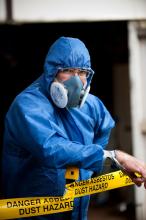- Home
- Removing or disturbing asbestos
- Wearing protective equipment
Asbestos
Wearing protective equipment
Wearing the right personal protective equipment is essential to protecting your health when working with asbestos. Personal protective equipment is available from most hardware or safety equipment suppliers.
A range of personal protective equipment (PPE) should be worn by workers to protect them from exposure to airborne asbestos fibres, including:
- P2 disposable mask or a half-face respirator
- disposable coveralls suitable to the task , for example, European Standards Type 5 and Type 6
- face and hand wipes
- boot covers or gumboots.
Wear the proper respirator
Ordinary dust masks are not effective in preventing the inhalation of asbestos fibres and dust. Cheap masks may save dollars but they do not provide adequate protection against airborne asbestos fibres.
You will need to purchase and use a specific respirator designed specifically for working with asbestos. Wear a half-face filter respirator fitted with a class P1 or P2 filter cartridge, or a class P1 or P2 disposable respirator appropriate for asbestos. These respirators are available from safety shops or hardware stores.
Respirators should comply with Australian Standard AS1716. This number should be displayed somewhere on the mask.
Males should be clean-shaven to make sure there is a clean seal between their face and the mask. The respirator should have an airtight fit. Read and follow the manufacturer's instructions on how to check the fit of the respirator.
Keep your respirator on until all work and clean up is done and your contaminated clothing is removed, bagged and sealed.
Wear disposable clothing
Disposable coveralls should be used to prevent the contamination of any clothing, including your shoes/boots. These respirators are available from safety shops or hardware stores. A disposable hat and disposable gloves should also be worn.
Do not keep the clothing, reuse them or shake the dust out of them. After your work is complete, spray your clothing with a light mist of water and remove them. Keep your respirator on when doing this. Seal all of these in your asbestos waste bags for disposal (contaminated clothing can be disposed of with other asbestos waste). Read more information about disposing of asbestos waste.
Have a shower afterwards
To remove any dust and asbestos that may be on your body, have a thorough shower after finishing your work. Make sure you wash your hair as well.
It's essential that you take all the necessary precautions to protect yourself and others when dealing with asbestos. Find out about preparation before you commence the task.

- Home
- General information
- What is asbestos?
- How was asbestos used?
- Are there health effects?
- The risks of exposure
- Health monitoring
- Legislation and codes of practice
- Low density asbestos fibre board
- Asbestos contaminated dust or debris
- Fires
- Cleaning up after floods and storms
- Importation prohibited
- Government and agency roles
- Asbestos in government assets
- Know where asbestos is
- Removing or disturbing asbestos
- Practical guidance
- Resources
- Asbestos alerts
- Asbestos news
- Codes of practice
- Guidance
- Films
- Asbestos safety session 2021
- Asbestos safety session 2020
- Cleaning Asbestos Roofs
- Shadow vacuuming with a H-Class vacuum cleaner
- Use and maintenance of a H-Class vacuum cleaner
- Identifying low density asbestos fibre board hazards and risks
- Working safely with asbestos for the home renovator
- How to properly wear personal protective equipment for airborne contaminants
- Personal protective equipment
- Dear Dad - An asbestos awareness film
- Clear and present danger: Asbestos exposed
- Uses and applications of asbestos - an extract from a film by Parsons Brinckerhoff
- Asbestos health issues - an extract from a film by Parsons Brinckerhoff
- Safe work procedure - storm and wind damage cleanup
- Drilling into asbestos walls and ceilings
- Asbestos - Removing switchboard panels
- Decontamination procedure, personal decontamination and cleanup procedures
- Asbestos awareness
- Safe work procedures
- Preparation before commencing the task
- Preparing and painting corrugated asbestos cement roof and fences
- Drilling into non-friable asbestos using a thickened substance to control airborne fibres and dust
- Drilling into non-friable ACM using an H rated industrial HEPA filter vacuum to control airborne fibres and dust
- Removing a small package electrical switchboard
- Cleanup and disposal
- Safe cleanup of storm damaged materials that may contain asbestos
- Frequently asked questions for homeowners and the general public
- Podcasts
- Strategies
- Working Safely with Asbestos Guide
- Asbestos awareness week 2025
- Asbestos management compliance campaign
- Induction and safety training for unlicensed work
- Sanctions